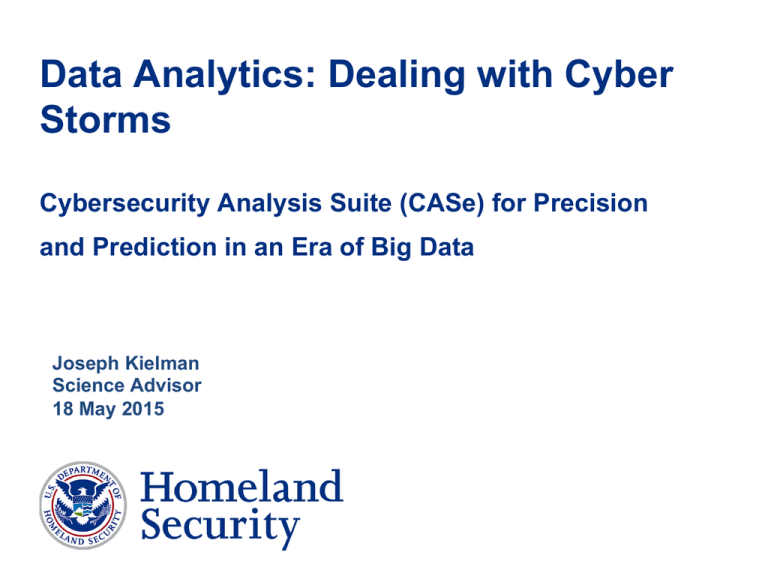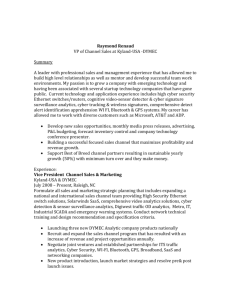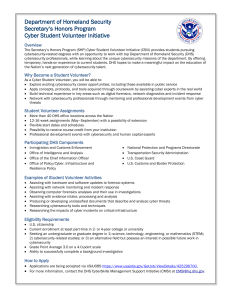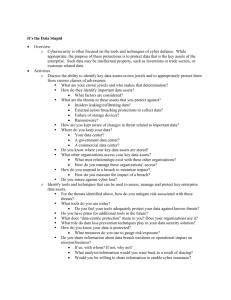Data Analytics: Dealing with Cyber Storms Cybersecurity Analysis Suite (CASe) for Precision
advertisement

Data Analytics: Dealing with Cyber Storms Cybersecurity Analysis Suite (CASe) for Precision and Prediction in an Era of Big Data Joseph Kielman Science Advisor 18 May 2015 PART 1: Operational Need § Data analysis challenges are well documented* § Annual global IP traffic will surpass the zettabyte threshold (1.3 zettabytes) by the end of 2016. In 2016, global IP traffic will reach 1.3 zettabytes per year or 110.3 exabytes per month. § Global IP traffic has increased eightfold over the past 5 years, and will increase threefold over the next 5 years. Overall, IP traffic will grow at a compound annual growth rate (CAGR) of 29 percent from 2011 to 2016. § In 2016, the gigabyte equivalent of all movies ever made will cross global IP networks every 3 minutes. Global IP networks will deliver 12.5 petabytes every 5 minutes in 2016. § The number of devices connected to IP networks will be nearly three times as high as the global population in 2016. § This work focuses on the analysis portion of the data processing cycle and applying it to the cyber security environment § US CERT projects need for analysis will rise to 10B events/day when EINSTEIN 3 becomes operational § Predictive analysis will help anticipate cybersecurity events – key as number and frequency of events increases *Source: CISCO VNI forecast, 2011-2016 2 Predictive/Prospective Policy Context, Culture, Genes Cognitive/Behavioral Analytics Prediction Visual Analytics Synthesis Analysis Graph Matching Cognition Evidence Extraction Organization Pattern Analysis Content Management Link Discovery Integration Connect the Dots Extraction Discovery Aggregation Data Information Knowledge Wisdom Analytics for Complex Information (ACI) Being Prospective rather than Retrospective means enabling users to harness Massive data, which comes in Multiple modes and Multiple types, through Multiple devices, in Diverse user environments, In order to make decisions in real-time. Dynamic Information Made Actionable In RealTime Information after Analytics • What part is relevant? • Am I missing something? • What does it mean? • When will I need it? • How do I use it? • Can I trust it? • Is it private or personal? • How do I convey it to others? • When can I take actions with it? And which ones? • How will others see it? • How should I interact with it? Other Issues with Digital Data • Data Archiving • How and where to store it? • What do we do about clouds, warehouses, and websites? • Data Permanence • How long will it last? • Data Rendering • What will we use to run it? • Regulatory or Legal Issues • How to deal with Digital Rights Management and piracy? • Who enforces the copyright? Science and Technology Principles What Is the Problem? Information -There are real-world [resiliency] issues for which the availability and usefulness of information is problematic How Do We Structure the Solution? Utility -The capabilities being developed must address at least four information-related concerns: increasing amounts and diversity of data compounded by multiplicity of users; indeterminate nature of relevance coupled with multiplicity and complexity of [threats] or problems What Is the Value of the Work? Outcome -The improvements being provided must have real-world outcomes or implications for the [homeland security] enterprise NOTE: Please replace words in [ ] with terms appropriate to your industry or affiliation. What We Want/Need/Expect from Analytics The Goal … A coherent story using complete, up-to-date information and with which we are comfortable in making decisions But … • How coherent? • How complete? • How current? • How comfortable? So … § Risk measures § Confidence limits PART 2: Program Objectives and Design q Develops and delivers capability to discern, analyze and investigate, and predict multiple, large-scale cybersecurity threats to critical infrastructures q Addresses both DHS components’ investigative and protective missions and the requirements of the recent Executive Order and Presidential Policy Directive q Delivered in three stages tailored for successively more complex applications § Standalone system addressing localized to nation-wide to global financial crimes and cyber attacks by individuals and criminal networks § Networked capability allowing distributed toolsets and data sources to be readily applied to address large-scale, distributed attacks on multiple infrastructure sectors § Public-Private Partnership using matching private sector funds to deliver a common cyber threat and situational awareness capability for multiple, linked infrastructures q Enhances system performance and ROI with each discrete implementation stage § Relies on previously developed tools, frameworks, and systems as well as others currently under development to replace largely manual, case-specific methods § Integrates and scales capabilities to provide real-time analysis of developing cyber infrastructure attacks at levels of tens of billions events or transactions § Enables interdiction of criminal activities or cyber attacks before they become widespread or severe as well as forecasting or prediction of potential cyber threats 9 EO-13636/PPD-21 Requirements § PPD-21 dated 2/12/13 calls for the following: § Strategic Imperative 3 calls for implementing “An integration and analysis function to inform planning and operational decisions regarding Critical Infrastructures (CI)” § DHS to: “Maintain national critical infrastructure centers that shall provide a situational awareness capability that includes integrated, actionable information about emerging trends, imminent threats, and the status of incidents that may impact critical infrastructures” § DHS, “In conjunction with … other Federal Departments and agencies, to provide analysis, expertise and other technical assistance to CI owners and operators” § DHS to: “Support the Attorney General and law enforcement agencies with their responsibilities to investigate and prosecute threats to and attacks against critical infrastructure” § Integrated Task Force (ITF) Incentives Study in process. Cyber Security Division leading this engagement for S&T, which includes integration of the R&D requirements and strategy 10 Op Context Chart – Financial Crimes Current (As is) Various agencies and organizations are responsible for maintaining the integrity of the nation's financial infrastructure and payment systems. The y constantly implement and evaluate prevention and response measures to guard against electronic crimes as well as other computer related fraud. The financial industry estimates billions of dollars in annual losses associated with credit card fraud. Financial crime occurs Receive raw financial crime data via massive excel files T = days Organize and analyze data across mul+ple details (e.g. loca+on, +me, iden++es, etc.) T = weeks Determine responsible par+es, collect evidence for prosecu+on Prosecute responsible par+es Ongoing Collec+on/Analysis Current detection of financial crimes comes from the victim or the company holding the victim’s access and financial information • Financial crimes happen very quickly and are international in nature, as the same information can be sent around the world to other locations for action (e.g. ATM withdrawals simultaneously in US, UK, Germany, etc.) • Aware of the communities responsible for large-scale financial crimes, but difficult prosecuting the leads for these communities. • EX: Over 1 week in Feb. 2013, one incident with 42,000 transactions across multiple countries led to a total loss of $39M. The raw financial data comes in different ways, exported from different systems, into massive excel files • Evidence collection is collected by location, amount, and account information • Geolocation of events is difficult as each ATM, bank, etc. are not properly tagged with location data • Surveillance information at sites varies by country, city, town, etc. Determining responsible party(ies) is difficult and labor intensive • The “middle man” is easier to identify using camera and surveillance systems at the site of the crime, however, the larger organization and the individuals therein giving the orders and disseminating the financial information is harder to identify for prosecution Prosecuting responsible parties is difficult due to the level of data needed for prosecution is complicated and labor intensive • The “middle man” is easier to identify using camera and surveillance systems at the site of the crime, however, the larger organization and the individuals therein giving the orders and disseminating the financial information is harderName to identify for prosecution Presenter’s June 17, 2003 Version 12 (2-5-2013) 11 Op Context Chart – Financial Crimes U.S. Contractors Future (To be) Tools to help financial institutions identify events Anomaly detec+on within financial transac+ons T = minutes Apply WireVis to integrate data into transac+onal database with visualiza+on interface for analysis and data manipula+on Financial crime occurs Receive raw financial crime data Organize and analyze data across mul+ple details (e.g. loca+on, +me, iden++es, etc.) Determine responsible par+es, collect evidence for prosecu+on Prosecute responsible par+es Ongoing Collec+on/Analysis Support initial anomaly detection activities of Federal Government and its major partners • Currently receives cluttered raw data in varied forms, mostly via Excel files • If appropriate, major partners could link to the WireVis system to immediately • This would enable uniform data creation and sharing methods for the US and its major partners Apply the WireVis tool to enable faster organization, analysis, and understanding of financial crimes data (minutes vs. days) • WireVis was developed to investigate money-laundering & fraud; can be applied to everything from risk analysis to financial business intelligence • This tool was developed by UNCC with the support of S&T’s Office of University Programs and Bank of America • Supports highly interactive exploration from a grand overview to particular cases Determining responsible party(ies) would remain the job of the US experts, but WireVis could help them sift through the large amounts of data in a more timely and effective data to support conclusion finding Prosecuting responsible parties Return on Investment Annual capability and/or efficiency improvements: • Process more data in a more cost and time effective manner • Supports better understanding of criminal network strategies and practices, which could lead to more arrests and prosecutions Millions of U.S. dollars saved by disrupting the communities responsible for large-scale financial Presenter’s Name June 17, 2003 crimes around the world 12 Impact on Operations Financial Fraud Investigation (As-Is) Collect Fraud Data 0 Day Extract Data & Upload (Transaction and IP Tags) Time = Days Analyze Data (PatternsTrends) Time = Weeks Share & Disseminate Days+60 Financial Fraud Investigation (To Be) Collect Fraud Data Extract Data & Upload (Transaction and IP Tags) Analyze Data (PatternsTrends) Visualize (Spatial/temporal) Share & Disseminate Store (Future pattern recognition) **Additional Capability 0 Hour 0.25 hours 0.5 hours 0.75 hours 2.00 hours 13 Return on Investment (ROI) § Analyst workload impact § One case that takes 60 days, using two analysts: § As is: 480 analyst hours x $32.93/hr = $15,806 § To be: 4 analyst hours x $32.93/hr = $131.72 § Using some of the FY 11 data on case loads: § 125 disaster fraud investigations opened, 1000+ ongoing § Undisclosed # of mortgage fraud investigations § Undisclosed # of Electronic crimes cases, including financial fraud § Very roughly 250 cases x $15K labor savings per case = ~$3.75M in analyst hours in first year Assumes 13% rise in case load each year 14 Cybersecurity Foundations § VASA – Visual Analytics for Security Applications § Joint Germany-US research program § Three-year effort with 10 partner institutions § Focus is on Critical Infrastructures § Understanding and Disrupting the Economics of Cybercrime § DHS/S&T Cyber Security Division program funded through White House CNCI § Carnegie-Mellon University is prime § Focus is twofold: identifying disincentives and understanding criminal behaviors § LINEBACkER – Line-speed Bio-inspired Analysis and Characterization for Event Recognition § Another White House CNCI initiative § Prime is Pacific Northwest National Laboratory § Focus is distributed, early warning of possible cyber attacks 15 Visual and Data Analytics for Cybersecurity Heterogeneous Data Situational Awareness + - Diverse - Diffuse - Distributed Predictive Insights Analysis Analytic Tool Description Performer Investment to Date Status Traffic Circle and Clique Cyber threats analysis tools for network attacks PNNL Basic capability funding, $2.75M US CERT and other implementation, $1.5M Pilot deployment at US CERT In-spire Text analysis tool now being applied to cyber threat data PNNL/U Ill UC Basic capability, $3.5M Cyber threat application, $200k Deployed @NBIC Precision Information Environment (PIE) Situational awareness and decision-making for large-scale, multiagency emergency response actions PNNL $2.25M Deployed w/ FEMA Region X GREEN Suite Near real-time analysis of threats, risks vulnerabilities of Power Grid PNNL $3.5M S&T funding. Co funding from IC, DOE, and Bonneville Power Deployed at Bonneville Power Admin WireVis Financial fraud analytical tool UNCC $1.75 S&T (COE) funding, $5M Bank of America (BofA) funding Deployed at BofA 16 Technical Approach Analytic Tool Data Inputs Data Outputs Capacity (As Is) Capacity (to Be) Wire Viz Structured, Semi Structured financial transaction data Heatmap (Clustering), Similarity based comparison, temporal relationships Query up to 10M data points/minute Modify to work for more general analysis applications CLIQUE Structured User defined temporal views, anomalous behavior Up to 100M records per query (laptop) Higher throughput possible when used with other appliances (Neteeza) PIE Structured, Unstructured (Text) Event tracking, Collaborative environment Up to 400k data points Up to 1M data points, add resource modeling and tasking, video &image Green Suite Multiple types of structured & unstructured data Geospatial (Location-connection) Physics (voltage-Current) Telecom (Phone calls, text messages) Link analysis, network analysis Up to 1M nodes (desktop) Up to 100M link queries/30 mins Scale to 1B link queries/30 mins 17 Program Timeline & Cost Data Analysis for Cybersecurity $6M 0 $7M Yr 1 $8M Yr 2 $3M Yr 3 Yr 4 Yr 5 Big Data Analytics for Cyber Security Time: 2 YRS Cost: $ 6M 1) Common Integrated analytical platform 2) Near real time processing of big data sets 3) Collection, Processing, Analysis, Sharing Homeland Security Data Analytics Network Time: 2 YRS Cost: $ 7M 1) Nationwide Computational a nd analysis network for real time i nsight i nto the cyber threat e nvironment 2) Analogous to the Big Science networks in place for grand scientific c hallenges Next Gen data a nd Interoperability for Cyber-­‐Disaster Management Time: 3 YRS Cost: $ 11M (Yr 1 , $ 8M, Yr 2 $ 3M) 1) Establish/Maintain public-­‐private partnership w/joint funding 2) Nationwide Computational a nd analysis network for real time i nsight into the cyber threat e nvironment 3) Address multiple, cascading e mergency response scenarios for interdependent c ritical i nfrastructures 4) Establish e ducation c omplex with c ompetitions a nd c hallenges 5) Addresses economics of, i nsurance for and risks of cyber threats 18 CASe Phase I Example Use Case: Financial Crime Event Development: Deliver an advanced data analysis tool to DHS and one financial institution in support of DHS financial fraud and electronic crime missions. Situational Awareness and Collaboration PIE CLIQUE WireVis Green Suite Network Activity Analysis tool Business processes tool for financial data Massive scale link analysis tool CASe er Oth ied tif Iden ta Da (e.g. Insurance fraud, ATM locations, card transactions) Financial Crime Event: 42,000 transactions over 1 week Loss of $39M Current Analysis: 4-weeks to On average, 80% of organize & analysts time is spent analyze giant Example organizing, not spreadsheet data analyzing problem - data Program Plan: 1 financial 1. Concept development/Requirements Analysis: Observe crime event & document DHS and financial institution analytic processes& operational Needs over the course 2. Design: AoA, Tech Foraging, Development strategy 1 week: 3. Development: Tailor/modify of existing tools to meet different requirements for DHS and Financial Institution, 42,000 increase application capacities transactions =a 4. Development testing. Test each application throughout development phase loss of $39M 5. Integration: Integrate CLIQUE, WireVis, Green Suite and PIE 6. Integration Testing 7. Pilot Deployment; Deploy integrated suite for piloting at both DHS and commercial facility 8. Finalize S/W and Documentation for customer acceptance and transition 9. Transition CASe Phase 1 Timeline Phase 1: Data Analytics Deployment to USSS Commercial Bank Phase I: Data Analytics Deployment to DHS andand Commercial Bank T = 0M 2M Project Approved 4M Concept Development $300K PNNL IA Awarded (Mod) UNCC Grant Awarded Req Analysis 1) Interviews 2) Review & document analytic proc-­‐ esses $450K 6M 8M 10M 1 YR Strategy ApprovedGo /No Go 14M 16M 18M Dev Review Go/No Go 20M 22M Integration Review Go/No Go 2 YR Dev Review Go/No Go Design $300K Development 1) Tailoring S/W based on analyst/business processes (e.g. Wire V is for UDHS SSS) 2) Increasing capacity for PIE 3) A dditonal data t ype handling for PIE $1.68M Development Testing $540K Integration -­‐ WireViz, CLIQUE, GREEN Suite & PIE $1.2M Integration Testing $660K Beta Deployment $120K Final S/W and document Production $150K Transition 20 Technical Approach § CASe Phase 1: Data Analysis Capability for Financial Sector § This program element delivers a standalone system addressing localized to nation-wide to global financial crimes and cyber attacks by individuals and criminal networks Phase Activities Outputs Cost Concept Development • Preliminary analysis • Initial transition strategy • Operational Needs statement $300K Requirements Analysis • Define KPP, interfaces, technical requirements • FRD • Tech Reqs Document • CONOPS (if required) $450K Design • Individual design features • Integrated design features • AOA Documentation • Sys Design Document $900K Development • Tailor PIE, WireViz, CLIQUE, Green Suite to desired reqs • Testable s/w modules & capabilities $1680K Development Testing • Analysis tool testing • Test plan/test report $540K Integration & Testing • Test integrated capability of 4 tools • Test plan/test report $1860K Pilot deployment • Deploy pilot • S/W fixes $120K Transition Prep • Final S/W builds • C&A Support • User/Admin guide $150K 21 CASe Phase II Development: Build a distributed, networked capability and incorporate additional analysis capabilities as required by respective infrastructures Expand CASe’s analysis capabilities by incorporating other tools, namely: • An investigative tool for modeling attacker behavior and criminal supply chains, and • A modeling capability for understanding interdependencies of critical infrastructure Develop a networked capability to access the CASe capability from distributed locations, effectively: • Capitalizing on larger available computing infrastructure • Increasing information sharing/ access • Better understanding of the sector’s data analysis needs, requirements, and future challenges PIE CMU VASA Attacker behavior & cyber crime supply chain models Critical Infrastructure interdependencies CLIQUE WireVis Green Suite er Oth a Dat CASe 22 CASe Phase 2 Timeline Phase 2: Homeland Security Analysis Network Phase 2: Homeland Security Analysis Network T = 0M Project Approved 2M 4M Concept Development $350K Req Analysis 1) Interviews 2) Review & document analytic proc-­‐ esses $245K 6M 8M 10M 1 YR Strategy ApprovedGo /No Go 14M 16M 18M Dev Review Go/No Go 20M Integration Review Go/No Go 22M 2 YR Dev Review Go/No Go Design $700K Development 1) Based ob BAA t opic awards, development will be required for t echnologies t o support distributed processing, storage retrieval 2) Tailoring CMU models 3) t ailoring WASA capabilities $1.47M Development Testing $385K Integration -­‐ WASA capability and Carnegie Mellon Cybercrime models into CASe baseline $2.52M Acquistion A pporach -­‐ BAA or fast t rack acq process Awards made Integration Testing $840K Beta Deployment $280K Final S/W and document Production $140K 23 Transition Technical Approach § Phase 2: Homeland Security Data Analysis Network § This program element aims to deliver a networked capability allowing distributed toolsets and data sources to be readily applied to address large-scale, distributed attacks on multiple infrastructure sectors. The end state will be a network for cybersecurity threat analysis and information sharing, analogous to the Big Science research networks. Phase Activities Outputs Cost Concept Development • Preliminary analysis • Initial transition strategy • Operational Needs statement $350K Requirements Analysis • Define KPP, interfaces, technical requirements • Multiple sector analysis • FRD • Tech Reqs Document • CONOPS (if required) $245K Design • Individual design features • Integrated design features • AOA Documentation • Sys Design Document $700K Development • Technologies to support distributed processing, storage retrieval • Tailoring CMU models • Tailoring WASA capabilities • Testable s/w modules & capabilities $1470K Development Testing • Analysis tool testing • Test plan/test report $385K Integration & Testing • Test integrated capability of 2 additional tools plus testing of distributed model • Test plan/report $3360K Pilot deployment • Deploy pilot to 2 sectors (ISACs) • S/W fixes $280K Transition Prep • Final S/W builds • C&A Support • User/Admin guide $140K 24 CASe Phase III Development: Advance public-private partnerships by engaging a number of committees and councils with missions to improve and secure the banking and financial sector “To continue to improve the resilience and availability of financial services, the Banking and Finance Sector will work through its public-private partnership to address the evolving nature of threats and the risks posed by the sector’s dependency upon other critical sectors.” – National Infrastructure Protection Plan, Banking and Finance Sector Sector & Global Dependencies: • The Department of the Treasury and the FBIIC have identified four important sector dependencies with the Banking and Financial Sector (BFS): 1. Energy 2. Information Technology 3. Transportation Systems 4. Communications • The BFS relies on an extensive and complex supply chain, often reaching to providers outside the U.S., including third-party providers. Financial and Banking Information Infrastructure Committee (FBIIC) • The international nature of financial services markets and the cross-border interdependencies in financial Financial Services Sector Coordinating Council (FSSCC) for Critical infrastructure require close cooperative Infrastructure Protection and Homeland Security (CIP/HLS) relationships with public-private sector organizations in major markets around the world. Financial Services-Information Sharing and Analysis Center (FS-ISAC) Others? • These relationships will ensure a coordinated approach to financial infrastructure protection around the globe. 25 End State and Impact § Desired end state: Data analytics capability, to include deployment at multiple nodes across the US, will help meet the requirements for increased situational awareness, information sharing and analysis and improved decision support required in PPD-21 PPD 21 Directive Data Analysis for Cybersecurity will: Provide a situational awareness capability that includes integrated, actionable information about emerging trends, imminent threats • Through nationwide network and public-private partnership, enable consistent collection and analysis of cyber-risk data from a range of government, industry, commercial, and internal sources to gain a more complete understanding of threats, risks and exposures • Provide predictive insights into actual conditions within and across multiple IT environments, including insight that can identify anomalous behavior • Enable the storage, retrieval and analysis of massive historical data sets in real time to identify anomalous activity In conjunction with the SSAs and other Federal Departments and agencies, provide analysis, expertise and other technical assistance to CI owners and operators • Establish public-private partnership to support increased information sharing between public and private domains • Increased analytical capability to ISACs and other public-private nodes through technology and educational/competition component Support the Attorney General and law enforcement agencies with their responsibilities to investigate and prosecute threats to and attacks against critical infrastructure • Predictive insights can better guide allocation of scare investigative resources • Discover of non obvious relationships for both investigative and prosecutorial purposes Integration and analysis function to inform planning and operational decisions regarding CI • Allow modeling & simulation for multiple, complex and cascading emergency response scenarios for interdependent critical infrastructures • Provide economic risk and analysis 26 Technical Aspects § Technical approach § Sample analysis of who is addressing which parts of the digital data analysis lifecycle through their respective R&D programs: Agency Programs Collect DARPA - Anamoly Detection at Multiple Scales (ADAMS) DARPA - Video Image Retrieval and Analysis Tool (VIRAT) DARPA - Cyber Insider Threat (CINDER) DOE - High Performance Storage System (HPSS) NASA Earth Observing System Data and Information System (EOSDIS) NSF - BIGDATA CSD - Data Analysis for Cybersecurity Curate Store Digital Data Life Cycle Steps* Search Retrieve Analyse Visualize Share X X X X X X X X X X X X X X X X X § Note: No agencies currently examining data analysis for the unclassified cybersecurity domain across multiple steps in the analysis process Source: Harnessing the Power of Digital Data for Science and Society, January 2009, Interagency Working Group on Digital Data , National Science and Technology Council 27 Return on Investment § Limited data available for analysis for Cybersecurity applications, however: § McKinsey Global Institute report found that up to $200B in savings could be realized in the US Health Care Market through implementing big data analytic approaches to develop or improve: § Comparative effectiveness research (CER) § Clinical decision support system § Predictive modeling § Clinical trial design § McKinsey report also estimated potential operating cost savings of 10-25% the manufacturing sector by using sensor data–driven operations analytics. This has obvious analogies in cybersecurity, where massive data sets available from the sensor grid of the “Internet of Things” could provide near real time indications and warnings *Source: Big Data: The Next Frontier for innovation, competition and productivity, McKinsey Global Institute, June 2011 28 Success and Transition § Potential Partnerships § Strategic: § Agency level partnerships with Department of Commerce (NIST), Department of Justice, and Intelligence Community per Executive Order and PPD-21 § NITRD chartered Big Data Senior Steering Group. Current focus is climate change modeling, materials genome, and health records § National "Big Data Initiative“ comprising six Federal departments and agencies committing more than $200 million to big data research projects § Tactical/Departmental Level: • CBP CISO, NPPD/CS&C/US CERT, DHS CIO, USSS • DHS component requirements, as expressed in the “Big Data” Steering Committee report § Commercialization plan: The desired end state is a public-private partnership technologies developed and integrated will be used in a public-private partnership 29 Program Management § Acquisition Strategy § Type of performer (national lab, academic institution, private sector) • Initial efforts with National Laboratories and Center of Excellence schools • BAA would be the preferred, long-term solicitation vehicle; LRBAA Topic CSD.17 Open § For each program element, plan to release BAA outlining the research requirements for each § Cost sharing will be in the form of component or customer participation in technology pilots, analytic and design reviews, requirements integration § Deliverables will be based on each contract and will vary by program element 30 Technical & Policy Risks § Technical risks to this project § Pace of data growth could outstrip traditional R&D timeline (Mitigation: Explore Cyber Fast Track (CFT) like project; discussions underway between CSD, DHS OPO & DARPA) § Analyzing, measuring, and ranking the provenance of massive heterogeneous data sources § Policy risks § Information sharing policies could inhibit effectiveness of sharing process § Privacy concerns around the topic of data gathering and analysis § Working in concert with CSD Data Privacy Technology program 31 Summary - CASe • Applies modern informa+cs and decision-­‐making techniques to issues of cybersecurity and cri+cal infrastructure protec+on • Develops and implements analy+cs capability for maintaining situa+onal awareness of and managing widespread, catastrophic cyber emergencies • Addresses na+onal-­‐level requirements outlined in the recent cybersecurity Execu+ve Order and Presiden+al Policy Direc+ve • Structured as three-­‐phase program, beginning with an agency mission-­‐ specific need and ending with a public-­‐private partnership • Enables return on investment to be determined at conclusion of each phase • Relies on available technologies: a few, basic capabili+es with known performance specifica+ons • Will be pursued through BAAs • Looking for partners 32 PART 3: Looking to the Future • Cyber Health • LINEBACkER • Anomaly Detec+on • Reputa+on-­‐based Security • Cyber Resilience – Workshop: 17-­‐18 November 2014 – US-­‐UK Collabora+on – Book to be published Fall 2015 • Cyber Iden+ty – Workshop: 30 June – 1 July, Rutgers University – Na+onal Conversa+on 33 Cyber Resilience • Theme 1 – Securing Infrastructure from Cyber Disrup+ons – Situa+onal Awareness for Resilient Cyber Infrastructures – Architecture and Design for Resilient Systems – Understanding the Unique Aspects of the restora+on/Recovery of Infrastructure and Social Networks from Cyber Aaacks • Theme 2 – Modeling and Measuring Societal Resilience – Cyber Threats and the Percep+on of a Dependent Society – Dynamic Topologies of Responsibili+es and Governance in a Cyber-­‐ disabled Era – Cyber Threats in the Context of a Challenged and Changing World Order • Theme 3 – Streaming Analy+cs for Effec+ve Data Exploita+on – Cyber Decision-­‐making in the Presence of Noisy, Voluminous Data, Using Gold-­‐Standard Analogies – Privacy-­‐preserving Informa+on Sharing – Modeling, Monitoring, and Recognizing Poten+ally Dangerous Changes to Cyber Situa+ons – Cascading Impact: Mul+dimensional Analysis of Infrastructural, Societal, and Vulnerability Networks 34 Cyber Identity • Theme 1 – Iden+ty Proofing in the Era of Social Media and Data Breaches • Theme 2 – Provenance for the “Internet of Things” • Theme 3 – Metrics for Trust Par$cipa$on in the Workshop and Na$onal Conversa$on Town Mee$ng is Welcome 35 Ques+ons or comments: joseph.kielman@dhs.gov 36





